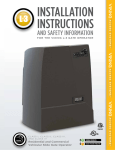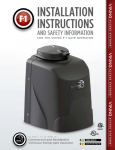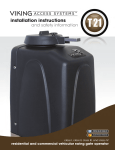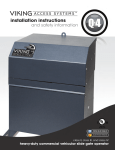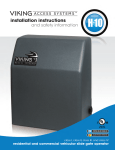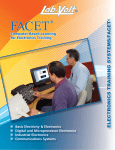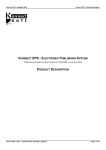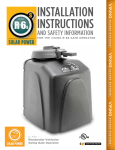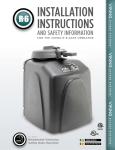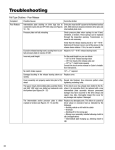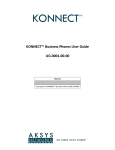Download Manual - Viking Access
Transcript
INSTALLATION INSTRUCTIONS AND SAFETY INFORMATION F O R T H E V I K I N G Q -7 G AT E O P E R ATO R CLASS II, CLASS III, AND CLASS IV Heavy-Duty Commercial Vehicular Slide Gate Operator The Q-7™ gate operator has the capacity to operate slide gates up to 7000 lbs. and 120 ft. in length at 100% duty cycle under extreme conditions. This efficient operator provides a solution for high traffic commercial and industrial slide gate applications. The Viking Q-7™ gate operator offers efficiency and technology combined in a single package. THE VIKING Q-7™ SLIDE GATE OPERATOR Q-7 Vehicular Gate Operator • Revision Q7NXMN10.E • December 2013 PARTS DIAGRAM: Item Description 2 Part No. 1 Chassis VAQ7CH10 2 Chassis Top Cover VAQ7CHTC10 3 Q7 Cover Lock (2) VAQ7CL 4 Chassis Front Cover VAQ7CHFC10 5 Chain Guard VAQ7CHCG10 6 Q7 J-Box Cover VAQ7JBC 7 Battery DUBA35 8 Loop Rack VA-LR 9 Control Board VFLEXPCB-Q7 10 Fuse - 4 amp VNXF4A 11 Fuse - NOT USED N/A 12 Release Handle VNXQ7RH 13 Manual Release Sensor DNXTS10 14 Q7 Gearbox Q7GB70 15 Q7 Motor VAQ7MO 16 Brush Kit VAQ7MBK 17 Electronic Positioning Sensor 2 (EPS2) VNXSLEPS2 18 Motor Breaker VAQ7MB20 19 Chain #50 x 10’ x 3 Q4C50CHK 20 23B50 Sprocket Q7SP50 21 Idler Pulley VAQ4IP 22 Idler Pulley Bushing VNXQ7IB20 23 Alarm DUAL10 24 Battery Switch DUMRS20 25 Q7 Power Box Assembly VNXQ7PBA 26 Receptacle 120V DUOL120 27 Motor Power Switch DUMRS10 28 EMI Board VNXDUEMI 29 AC Power Switch DUMRS20 30 EMI Fuse Holder & Harness VNXEFHH 31 Fuse - 8 amp DUF8EMI 32 Toroidal Transformer - 15 amp DUTT15 33 Motor Harness VNXQ7MH 34 Power Harness VAQ7PH VIKING TECHNICAL SUPPORT 1.800.908.0884 OPERATOR REFERENCES: 1. FRONT COVER 10.POWER BOX ASSEMBLY removable; convenient access to the power supply 2. COVER LOCK (2) components 3. TOP COVER 11. MOTOR POWER SWITCH & breaker; provides additional protection for 4. LOOP RACK switch the motor circuitry . for convenient loop detector installation 12.EMI FUSE 5. VFLEX CONTROL BOARD main power supply protection 6. MOTOR BREAKER 13. J-BOX resetable; protects the motor circuitry high voltage power supply connection 7. EPS2 (ELECTRONIC POSITIONING SENSOR) 14.MANUAL RELEASE HANDLE sensor for the digital limits convenient mechanical gear release 8. MOTOR 15.BATTERY BACKUP SYSTEM backup power supply in case of power outage; 9. BATTERY SWITCH 24V/35Ah disconnects batteries from the charging circuit during troubleshooting VIKING TECHNICAL SUPPORT 1.800.908.0884 3 CONTROL BOARD REFERENCES: 1. POWER HARNESS CONNECTOR provides power to the control board. pg 18-19 2. “OPEN LEFT” & “OPEN RIGHT” provides power to the motor. pg 20 3. LIMIT SETUP BUTTONS sets limit positions. pg 20-21 4. FEATURE ACTIVATION TRIM POTS activate and set features. pg 24 5. “EPS1” CONNECTOR monitors manual release operation. 6. “EPS2” CONNECTOR monitors the limit positions. 7. EMI BOARD CONNECTOR monitors the high voltage power supply. 8. “CHECK MOTOR” Status LED indicates motor power status. pg 36 9. “BATTERY LOW” Status LED indicates battery power status. pg 36 10. “POWER” Status LED control board power status. pg 18,36 4 11. “MAGNETIC LOCK RELAY” Status LED status of this on-board relay. pg 34, 36 21. “DIAGNOSE” Button allows you to navigate through the Diagnostics LCD Display. pg 38-40 12. “MAGNETIC LOCK RELAY” Terminal Block 22. “DIAGNOSE” LED connect electric locks here. pg 34, 36 informs that errors have been detected 13. INPUT STATUS LEDs and available on LCD Display. pg 38-40 indicates input status. pg 36-37 23. LCD DIAGNOSTICS DISPLAY 14. ACCESS CONTROL TERMINAL BLOCKS provides error messages, diagnostics accessory connections. pg 29-32, 42-44 settings and operator status information. pg 38-40 15. “MASTER/SLAVE” Terminal Block wired master/slave connection. pg 22 24. EXPANSION PRODUCT CONNECTIONS connections for additional products 16. CONTROL BOARD MOUNTING HOLES from Viking Access Systems. pg 46 secures and grounds the control board. 25. “FAIL SAFE/SECURE” Jumper 17. “Siren” Terminal Block not applicable to this model. Vikings UL Siren is connected here. 26. NOT USED 18. ON-BOARD 3 BUTTON STATION controls the gate during set up. 27. FUSE HOLDER - 4 AMP for charging circuit. 19. “AUX PWR” Terminal Block used for solar applications & in-motion 28. HEAT SINK warning devices. pg 19, 25 secures the control board and dissipates heat. 20.FEATURE ACTIVATION PIN HEADERS activate features by placing a jumper onto the pin headers. pg 25 VIKING TECHNICAL SUPPORT 1.800.908.0884 TABLE OF CONTENTS: PARTS DIAGRAM/PARTS LIST OPERATOR REFERENCES CONTROL BOARD REFERENCES IMPORTANT SAFETY INFORMATION Important Safety Instructions Important Installation Instructions Maintenance General Safety Precautions Operator Classification Photo Beam (non-contact sensor) Installation Edge Sensor (contact sensor) Installation Manual Release Audible Alarm Reset Installation Warning Placard Installation IMPORTANT INSTALLATION INFORMATION Specifications 2 3 4 6-12 6 7 8 8-9 9 10 11 11 12 12 13 13 GATE OPERATOR INSTALLATION 14-17 Concrete Pad Installation Positive Stop Installation Operator Positioning 14 15 16-17 ELECTRICAL INSTALLATION High Voltage Supply Option Solar Supply Option LIMITS SETUP MASTER/SLAVE SET UP Two Wire Communication Wireless Communication Options CONTROL BOARD SETUP 18-19 18 19 20-21 22-23 22 23 24-27 Initial Settings 24-25 Obstruction Detection Sensor (Primary Entrapment Protection) 26 Heater, Lock Mode................................................................................................................. 27 ACCESSORY CONNECTIONS Re-Open Photo Beam (Vehicular Safety) Radio Receiver (Typical) Anti-Tailgate, Open Commands, Guard Station Viking Loop Rack Guidelines for Loop Installations Magnetic Lock, Lock Solenoid Barrier Arm (B-12) Synchronization Option TROUBLESHOOTING 29-35 29 30 31 32 33 34 35 36-41 LED References LCD Display References Solutions 36-37 38-40 41 APPENDIX A, B & C VIKING EXPANSION PRODUCTS 42-45 46 VIKING TECHNICAL SUPPORT 1.800.908.0884 5 IMPORTANT SAFETY INFORMATION ! WARNING! Not Following these instructions may cause severe injury or death. IMPORTANT SAFETY INSTRUCTIONS ! WARNING! To reduce the risk of severe injury or death. 1. READ AND FOLLOW ALL INSTRUCTIONS . 2. Never let children operate or play with gate controls. Keep the remote away from children. 3. Always keep people and objects away from the gate. NO ONE SHOULD CROSS THE PATH OF THE MOVING GATE. 4. Test the gate operator monthly. The gate MUST reverse on contact with a rigid object or when an object activates the non-contact sensors. Af ter adjusting the force or the limit travel, retest the gate operator. Failure to adjust and retest the gate operator properly can increase the risk of injury or death. 5. Use the emergency release only when the gate is not moving. 6. KEEP GATES PROPERLY MAINTAINED. Read the user’s manual. Have a qualified service person make repairs to gate hardware. 7. The entrance is for vehicles only. Pedestrians must use a separate entrance. 8. Every gate operator installation MUST have secondary protection devices against entrapment, such as edge sensors and photo beams more in particularly in places where the risk of entrapment is more likely to occur. 9. SAVE THESE INSTRUCTIONS . IMPORTANT INSTALLATION INSTRUCTIONS 1. Install the gate operator only when: a. The operator is appropriate for the construction of the gate and usage Class of the gate (refer to page 9), b. All openings of a horizontal slide gate are guarded or screened from the bottom of the gate to a minimum of 6 feet (1. 83 m) above the ground to prevent a 2-1/4 inch (57. 2 mm) diameter sphere from passing through the openings anywhere in the gate, and in that portion of the adjacent fence that the gate covers in the open position, c. ALL EXPOSED PINCH POINTS ARE ELIMINATED OR GUARDED, AND d. GUARDING IS SUPPLIED FOR EXPOSED ROLLERS . 2. The Operator is intended for installation only on gates used for vehicles. Pedestrians must be supplied with a separate access opening. The pedestrian access opening shall be designed to promote pedestrian usage. Locate the gate such that persons will not come into contact with the vehicular gate during the entire path of travel of the vehicular gate. 3. The gate must be installed in a location so that enough clearance is supplied between the gate and adjacent structures when opening and closing to reduce the risk of entrapment. Swinging gates shall not open in to the public access areas. 4. The gate must be properly installed and work freely in both directions prior to the installation of the gate operator. Do not over-tighten the operator clutch or pressure relief valve to compensate for a damaged gate. 5. The gate operator controls must be placed so that the user has full view of the gate area when the gate is moving AND AWAY FROM THE GATE PATH PERIMETER. 6 VIKING TECHNICAL SUPPORT 1.800.908.0884 IMPORTANT SAFETY INFORMATION ! WARNING! Not Following these instructions may cause severe injury or death. IMPORTANT INSTALLATION INSTRUCTIONS (Continued) 6. Controls intended for user activation must be located at least six feet (6’) away from any moving part of the gate and where the user is prevented from reaching over, under, around or through the gate to operate the controls. Exception: Emergency access controls only accessible by authorized personnel (i.g. fire, police, EMS) may be placed at any location in the line-of-sight of the gate. 7. The Stop and/or Reset button must be located in the line-of-sight of the gate. Activation of the reset control shall not cause the operator to start. 8. A minimum of two (2) WARNING SIGNS shall be installed, one on each side of the gate where easily visible. 9. For gate operators using non-contact sensors (Photo Beams or like) in accordance with section 31.1.1 of the UL standard: a. See instructions on the placement of non-contact sensors for each type of application (refer to page 10). b. Care shall be exercised to reduce the risk of nuisance tripping, such as when a vehicle, trips the sensor while the gate is still moving, and c. One or more non-contact sensors shall be located where the risk of entrapment or obstruction exists, such as the perimeter reachable by a moving gate or barrier (refer to page 10). d. Use only Omron E3K-R10K4 photoelectric eye to comply with UL 325 10.For a gate operator utilizing a contact sensor (Edge sensor or like) in accordance with section 31.1.1 of the UL 325 standard: a. One or more contact sensors shall be located where the risk of entrapment or obstruction exists, such as a the leading edge, trailing edge, and post mounted both inside and outside of a vehicular horizontal slide gate (refer to page 11). b. One or more contact sensors shall be located at the bottom of a vehicular vertical lif t gate. c. One or more contact sensors shall be located at the pinch point of a vehicular vertical pivot gate. d. A hardwired contact sensor shall be located and its wiring arranged so that the communication between the sensor and the gate operator is not subject to mechanical damage. e. A wireless contact sensor such as one that transmits radio frequency (RF) signals to the gate operator for entrapment protection functions shall be located where the transmission of the signals are not obstructed or impeded by building structures, natural landscaping or similar obstructions. A wireless contact sensor shall function under the intended end-use conditions. f. One or more contact sensors shall be located on the inside and outside leading edge of a swing gate. Additionally, if the bottom edge of a swing gate is grater than 6 inches (152 mm) above the ground at any point in its arc of travel, one or more contact sensors shall be located at the bottom. g. One or more contact sensors shall be located at the bottom edge of a vertical barrier (arm). h. Only Use Miller Edge Model MGR20 or MGS20 edge sensor to comply with UL325. VIKING TECHNICAL SUPPORT 1.800.908.0884 7 IMPORTANT SAFETY INFORMATION ! WARNING! Not Following these instructions may cause severe injury or death. MAINTENANCE Remove the Power Harness from the Control Board. (refer to page 18) •Clean and lubricate the gate track wheels using the recommended lubricant. •Inspect the track for any signs of cracking or separation. •Check that all mounting hardware of the gate operator is properly tighten. •Ensure that the gate moves freely. •Check for corroded parts and replace if necessary. •Check the battery for the following: - Battery connections must be free of corrosion. - Battery voltage must be 26VDC (fully charged battery). Reconnect the Power Harness for the Control Board. (refer to page 18) •Check and confirm the proper operation of all safety devices (photoelectric eye, edge sensors or like). •Check and confirm the operation of all installed accessories. •Check and confirm the operation of all special features such as the Intelligent Obstruction Sensor, Hold Open Timer. (refer to page 24 and 26) •Check and confirm the operation of the manual release. (refer to page 7) •Verif y the functionally of the battery backup, or power failure option, by turning of f the main power source (115VAC or 230VAC). DO NOT FORGET TO TURN ON THE MAIN POWER SOURCE AFTER VERIFICATION. GENERAL SAFETY PRECAUTIONS The following precautions are an integral and essential part of the product and must be supplied to the user. Read them carefully as they contain important indications for the safe installation, use and maintenance. • These instruction must be kept and forwarded to all possible future users of the system. •This product must be used only for that which it has been expressly designed. •Any other use is to be considered improper and therefore dangerous. •The manufacturer cannot be held responsible for possible damage caused by improper, erroneous or unreasonable use. •Avoid operating in the proximity of the hinges or moving mechanical parts. •Do not enter the path of the moving gate while in motion. •Do not obstruct the motion of the gate as this may cause a situation of danger. •Do not allow children to play or stay within the path of the moving gate. •Keep remote control or any other control devices out of the reach of children, in order to avoid possible involuntary activation of the gate operator. •In case of break down or malfunctioning of the product, disconnect from the main power source. Do not attempt to repair or intervene directly, contact only qualified personnel for repair. •Failure to comply with the above may create a situation of danger. •All cleaning, maintenance or repair work must be carried out by qualified personnel. •In order to guarantee that the system works efficiently and correctly it is important to have the manufacturer’s instructions on maintenance of the gate and operator carried out by qualified personnel. •In particular, regular checks are recommended in order to verify that the safety devices are operating correctly. All installation, maintenance and repair work must be documented and made available to the user. 8 VIKING TECHNICAL SUPPORT 1.800.908.0884 IMPORTANT SAFETY INFORMATION ! CAUTION: To Reduce the Risk of Fire or Injury to Persons: a. Use only the following type and size battery(ies): Yuasa NP7-12 or VIKING DUBA12 b. Do not dispose of the battery(ies) in fire. The cells may explode. Check with local codes for possible disposal instructions. c. Do not open or mutilate the battery(ies). Released electrolyte is corrosive and may cause damage to the eyes or skin. It may be toxic if swallowed. d. Exercise care in handling batteries in order not to short the battery with conducting materials such as rings, bracelets and keys. e. Change the battery(ies) provided with or identified for use with this product only in accordance with the instructions and limitations specified in this manual. f. Observe proper polarity orientation between the battery(ies) and charging circuit. g. Do not mix batteries of differ ant sizes or from different manufactures in this product (applies to products employing more than one user replaceable secondary battery). h. A battery-operated product employing a secondary battery supply intended to be charged within the product shall contain specific instructions concerning the proper method of charging. UL325 Gate Operator Classifications GLOSSARY RESIDENTIAL VEHICULAR GATE OPERATOR CLASS I - A vehicular gate operator (or system) intended for use in garages or parking areas associated with a residence of one-to four single families. COMMERCIAL/GENERAL ACCESS VEHICULAR GATE OPERATOR CLASS II – A vehicular gate operator (or system) intended for use in a commercial location or building such as a multi-family housing unit (five or more single family units), hotel, garages, retail store, or other building servicing the general public. INDUSTRIAL/LIMITED ACCESS VEHICULAR GATE OPERATOR CLASS III – A vehicular gate operator (or system) intended for use in an industrial location or building such as a factory or loading dock area or other locations not accessible by or intended to service the general public. RESTRICTED ACCESS VEHICULAR GATE OPERATOR CLASS IV – A vehicular gate operator (or system) intended for use in a guarded industrial location or building such as an airport security area or other restricted access locations not servicing the general public, in which unauthorized access is prevented via supervision by security personnel. Install the gate operator only when: The operator is appropriate for the construction of the gate and the Usage Class of the gate. VIKING TECHNICAL SUPPORT 1.800.908.0884 9 IMPORTANT SAFETY INFORMATION ! WARNING! Not Following these instructions may cause severe injury or death. NOTE: This type on installation does not reverse the gate all the way back to its limits when the photo beam is obstructed. This installation is only to protect against entrapment and to comply with UL325. Secondary Entrapment Protection Photo Beam (non-contact sensor) Installation •Photo beams or like must be installed to reduce the risk of entrapment. •Use only Omron E3K-R10K4 photoelectric eye to comply with UL325 •Make the electrical connections of the photoelectric sensor as described here in this page. •Care shall be exercised to reduce the risk of nuisance tripping, such as when a vehicle, trips the sensor while the gate is still moving, and; •One or more non-contact sensors shall be located where the risk of entrapment or obstruction exists, such as the perimeter reachable by a moving gate or barrier. Consult the installation manual for the UL325 device (photo beam or like) for detail information about the usage, installation and maintenance. 10 VIKING TECHNICAL SUPPORT 1.800.908.0884 IMPORTANT SAFETY INFORMATION ! WARNING! Not Following these instructions may cause severe injury or death. NOTE: This type on installation dOEs NOT reverse the gate all the way back to its limits when the edge sensor is obstructed. This installation is only to protect against entrapment and to comply with UL325. Secondary Entrapment Protection Edge Sensor (contact sensor) Installation •Edge Sensors or like must be installed to reduce the risk of entrapment. •Use only Miller Edge 3-sided activation type MGR20 or MGS20 to comply with UL325 •One or more contact sensors shall be located on the inside and outside leading edge of a swing gate. Additionally, if the bottom edge of a swing gate is greater than 6 inches (152 mm) above the ground at any point in its arc of travel, one or more contact sensors shall be located on the bottom edge. 1. A hardwired contact sensor shall be located and its wiring arranged so that the communication between the sensor and the gate operator is not subjected to mechanical damage. 2. A wireless contact sensor such as one that transmits radio frequency (RF) signals to the gate operator for entrapment protection functions shall be located where the transmission of the signals are not obstructed or impeded by building structures, natural landscaping or similar obstruction. A wireless contact sensor shall function under the intended end-use conditions. Manual Release When manual operation is required: 1. Unlock and remove the Top Cover. 2. Lift the Release Handle up. To resume normal operation: 1. Push the Release Handle down. 2. Run the gate closed to search for the installed Positive Stop. (page 20 step 4) 3. Normal operation will now resume. VIKING TECHNICAL SUPPORT 1.800.908.0884 11 IMPORTANT SAFETY INFORMATION ! WARNING! Not Following these instructions may cause severe injury or death. Audible Alarm Reset Switch Installation Manual Reset for the Audible Alarm •UL325 standard requires an audible alarm to go off after two consecutive events detected by the primary entrapment protection of the gate operator (obstruction sensor). •The audible alarm will continue to sound for 5 minutes or until a stop command gets actuated. •The Stop command can be actuated in two different forms: 1. Using the Built in Stop switch on the Control Board or; 2. Using an External Stop button within the sight of the gate, away from moving parts of the gate and out of reach of children. a. Controls intended for user activation must be located at least six feet (6’) away from any moving part of the gate and where the user is prevented from reaching over, under, around or through the gate to operate the controls. Outdoor or easily accessible controls shall have a security feature to prevent unauthorized use. b.The Stop and/or Reset button must be located in the line-of-sight of the gate. Activation of the reset control shall not cause the operator to start. 2 Warning Placard Installation •All Warning Placards must be installed where visible in the area of the gate. •A minimum of two placards shall be installed. •A placard is to be installed in the area of each side of the gate and be visible. 12 VIKING TECHNICAL SUPPORT 1.800.908.0884 IMPORTANT INSTALLATION INFORMATION ! CAUTION: To Reduce the Risk of Fire or Injury to Persons: ! WARNING: For use with gates at a maximum 7000 lbs. in weight or 120 ft. in length. DO NOT allow pedestrian use of this gate DO NOT install the gate operator to lift gates Locate Control Buttons: 1. Within sight of the gate, 2. At a minimum height of 5 feet so small children are not able to reach it; and 3. At least 6 feet away from all moving parts of the gate. 7000 lb. 120 ft Specifications Maximum Gate Length: Maximum Gate Weight: Operating Temperature: Power Requirements: VIKING TECHNICAL SUPPORT 1.800.908.0884 120 ft. 7000 lb. -20°F (-28°C) to 160°F (71°C) 115 VAC / 230 VAC (8.0* amp / 4.0 amp) *Includes 3 amp load on receptacle Single Phase (50Hz / 60Hz) 13 GATE OPERATOR INSTALLATION Concrete Pad Installation 1. Follow the local building code to determine the required depth of the concrete pad. 2. Pad measurements recommended by Viking Access Systems are at least 28” long, 18” wide and 24” deep to ensure the stable operation of the operator, and a minimum of 4” above level grade to avoid any flooding of the machinery. 3. Provide a suf ficient number of conduit pathways for all low power accessories such as loop detector leads, maglock, non-contact sensors, contact sensors, safety and other commands. Also provide conduit for the power supply to the operator. ! DO NOT run low voltage and high voltage wiring in the same conduit. ! Provide at least 12 ” separation between low and high voltage conduits. 14 VIKING TECHNICAL SUPPORT 1.800.908.0884 GATE OPERATOR INSTALLATION Positive Stop Installation ! IMPORTANT: This operator REQUIRES that a positive stop be installed at the close position. This will be used as a reference to relearn the limit positions if the gate has been operated manually while released or if the EPS2 Cable has been disconnected. NOTE: Viking Access Systems does not provide any form of positive stops. Suggested Positive Stop Types: • Wheel stop affixed to the track • Gate catch plate, yoke or receiver VIKING TECHNICAL SUPPORT 1.800.908.0884 15 GATE OPERATOR INSTALLATION Operator Positioning ! IMPORTANT: All openings of a horizontal slide gate are guarded or screened from the bottom of the gate to a minimum of 4 feet (1.22 m) above the ground to prevent a 2-1/2 inch (57.2 mm) diameter sphere from passing through the openings anywhere in the gate, and in that portion of the adjacent fence that the gate covers in the open position. 16 VIKING TECHNICAL SUPPORT 1.800.908.0884 GATE OPERATOR INSTALLATION ! TECHNICAL TIP: Before completing the installation procedure; • Open and close the gate manually, making sure there is sufficient space between the gate and adjacent walls. • Check that the wheels are turning freely on the track and there are no restrictions while pushing the gate to the open and closed positions. • Confirm that there is adequate spacing for the guide rollers and that there are no restrictions throughout the travel of the gate. STEP 1 Before securing the chassis to the concrete pad or posts, make sure the gate and operator are LEVEL and PARALLEL. Minimum distance between the operator and gate is 2”. STEP 2 Chain Installation: Before welding the provided chain brackets, make sure the chain will be in a straight line with, and at the same height as, the chain leaving the gate operator rollers. VIKING TECHNICAL SUPPORT 1.800.908.0884 17 ELECTRICAL INSTALLATION High Voltage Supply Option ! Caution: Always turn off power breakers when working with high voltage. DO NOT connect the “Power Harness” to the Control Board until the electrical installation is complete and ready for verification. STEP 1 3d At the “Power Box”: a. Setet the “Voltage Selector” according to the supply voltage (115V or 230V). b. Turn the “AC Power” switch ON STEP 2 ! WARNING: SINGLE PHASE AC ONLY 3c At the “J-Box”: a. Connect the incoming power wires, matching the wire color codes. b. If the supply voltage is 120VAC, connect the red wire, labeled “Outlet Power”, to the neutral (white) wires. 1a STEP 3 3b a. Turn ON the main facility breaker b. Verify that all three (3) LEDs are illuminated at the “Power Box”. c. Turn the “Battery Switch” ON. 1b At the Control Board: d.Connect the Power Harness and verify the “POWER” LED is illuminated solid. ! TECHNICAL TIP: If the “Power” LED is flashing or any of the 3 LEDs on the “Power Box” are not illuminated, refer to the Troubleshooting pages. 2a Tips for proper ground installation: To minimize the effects caused by lightning, follow these guidelines. • Use a ground rod to provide a ground reference. • Consult your city code and be aware of under-ground services in the site of the gate operator to prevent inconveniences. • Always use a single bonding point for grounding. • All ground wires must be as short and as thick as possible. • Prevent unnecessary turns or loops in all ground wires. 18 VIKING TECHNICAL SUPPORT 1.800.908.0884 ELECTRICAL INSTALLATION Solar Supply Option ! IMPORTANT: The number of cycles achieved daily is dependent on many factors, including local solar radiation data and power consumption of the motor and accessories. It is very important that you consider this when using solar power. ! Tip: Solar efficency can be increased by activating the “Pre-Warning” A feature. The “Aux. Pwr” B terminals will then provide power to all nonessential controls beginning 3 seconds prior to gate movement and while the gate is moving. (page 25) A Connect the batteries in series. 24VDC B Disconnect the operators power harness and use the Solar Harness. ! IMPORTANT: Vikings Solar Package (part # VA-SOCHP) and its individual components are NOT RECOMMENDED for the Q-7 operator. Contact Viking Access Systems or your local solar provider for further information. VIKING TECHNICAL SUPPORT 1.800.908.0884 19 LIMITS SETUP ! IMPORTANT: 1. Before the initial limits setup, a Positive Stop MUST be installed at the close position. This will be used as a reference to relearn the limit positions if the gate has been operated manually while released or if the EPS2 Cable has been disconnected. 2. In the event of a complete power failure, including battery backup, the limit positions may have may been cleared and will need to be reset as described. STEP 1 Connect the “Motor Harness” to the Control Board. 1a 1b a. “OPEN LEFT” Connector if the gate opens to the Left, when viewed from inside. b. “OPEN RIGHT” Connector if the gate opens to the Right, when viewed from inside. STEP 2 STEP 3 Move the gate to the desired close position then press and hold the “Close Limit” button until the LED is solid. Move the gate to the desired open position then press and hold the “Open Limit” button until the LED is solid. “Close Limit” LED flashes if the close limit is not set. STEP 4 Run the gate in the close direction to search for the installed Positive Stop. This will be used as a reference. 20 “Open Limit” LED flashes if the open limit is not set. ! NOTE: For this 1st cycle, the gate will run slowly past the set close limit, contact the Positive Stop and reverse back. VIKING TECHNICAL SUPPORT 1.800.908.0884 LIMITS SETUP ! IMPORTANT: If the gate has been manually released and re-engaged: 1. The Open Limit LED will be illuminated solid and the Close Limit LED will be flashing. 2. The gate will not run in the open direction until step 4 is repeated on page 20. Open Limit Close Limit To Readjust the Close Limit: To Readjust the Open Limit: 1. 1. Clear the current limit setting by holding down the “Close Limit” button until the LED is flashing. 2. Repeat STEP 2 on page 20 to set the limit. 3. Repeat STEP 4 on page 20 to relearn the installed Positive Stop reference. VIKING TECHNICAL SUPPORT 1.800.908.0884 Clear the current limit setting by holding down the “Open Limit” button until the LED is flashing. 2. Repeat STEP 3 on page 20 to set the limit. 21 MASTER/SLAVE SETUP Two Wire Communication ! IMPORTANT: DO NOT run the Master/Slave communication cable in the same conduit or within 12” of 115 - 230v power supply cables. ! Technical Tip: DO NOT set the “Timer” and/or “Overlap” features on both operators Control Boards. Only turn these features on at the Master Control Board. CABLE REQUIREMENTS: • • • • 2 Conductor (wire) 18 AWG or better Shielded (overall foil) Drain Wire (non-insulated or bare wire) Conduit Drain Wire Shielded Cable Master Board Slave Board “MS1” “MS1” “MS2” “MS2” Conduit between Master and Slave 22 VIKING TECHNICAL SUPPORT 1.800.908.0884 MASTER/SLAVE SETUP Wireless Communication Options ! Technical Tip: DO NOT set the “Timer” and/or “Overlap” features on both operators Control Boards. Only turn these features on at the Master Control Board. REQUIRED ADD-ON: 1. Choose option A or B A.Viking Konnect - Wireless Master/Slave Kit PART#VA-KONNECT-MS B.Viking Blue - Wireless Master/Slave Kit PART#VA-BLUE-MSKT 2. Antenna Extension Cables (2) PART# VA-RPSMA Connect the Modules provided to the “V.K” plug & play connection of each operators Control Board. It is not important which board the master or slave module is placed on. Green LEDs will be illuminated solid when communication is ON. VIKING TECHNICAL SUPPORT 1.800.908.0884 23 CONTROL BOARD SETUP Initial Settings “Speed” Motor Speed “ODS” Obstruction Detection Sensor Increases or decreases the speed of gate travel. Sets the amount of force required to trip the inherent obstruction sensor. See page 26 for more details about this feature. “Overlap” Overlap Delay Delays the gate from opening for the selected amount of time from 1-6 seconds. ! Typically not used on slide gates. For Master/Slave application, the control board that has this feature turned on is the master and will close first. 24 “Timer” Hold Open Timer Automatically closes the gate after the selected amount of time from 1-60 seconds. Turning the dial between “0” and “OFF” will disable this feature, requiring a close command to close the gate. VIKING TECHNICAL SUPPORT 1.800.908.0884 CONTROL BOARD SETUP Initial Settings NOTE: Installing a shunt or jumper on the pins will activate the feature. “Auto Open” - Power Failure Option Opens the gate automatically during power failure. Resumes normal operation when power is restored. “Last Open” - Power Failure Option Opens the gate automatically when the battery backup voltage is critically low. “Pre-Warning” Initiates two options for an audio or visual warning 3 seconds prior to gate motion and will continue: 1. Until gate reaches closed limit: “Magnetic Lock” terminals provide a contact between “COM” and “N.O.”. 2. While gate is moving: “AUX. PWR” terminals provide 24VDC. “Sync” Used only in conjunction with the Viking Barrier gate operator model B-12. Activating this feature allows for synchronized operation with the B-12 operator. See page 35. “EXT” Available for future developments. ! IMPORTANT: Regardless of the power failure options chosen, the gate can be moved manually with a relatively low amount of force by following the steps for “Manual Release” as outlined at on page 11. VIKING TECHNICAL SUPPORT 1.800.908.0884 25 CONTROL BOARD SETUP Obstruction Sensor (Primary Entrapment Protection) ! IMPORTANT: The appropriate “ODS” setting is dependant upon the gate installation and construction. Set this feature accordingly. Additional Safety equipment should be used to reduce possible risk of injury or vehicle damage. “ODS” Obstruction Detection Sensor The Obstruction Sensor detects obstructions in the path of the traveling gate. The dial sets the amount of force required to activate the operators inherent obstruction detection. Setting the dial to “0” will require the least amount of force to activate; Setting the dial to “100” will require the maximum amount of force to activate. UL325 standard requires an audio alarm to go off after two consecutive entrapment events sensed by the Inherent Entrapment Protection of the Gate Operator. The audio alarm will sound for a period of 5 minutes or until a Stop command has been actuated. See page 12 for more information. When the Obstruction Sensor detects an obstruction it will: 1. Stop the gate’s movement and reverse it momentarily. 2. Bring the gate to a resting position. 3. Disable the Hold Open Timer feature until the Gate Operator receives a new command. If second obstruction is detected before the gate reaches either limit it will: 1. Stop the gate’s movement. 2. Disable the Gate Operator. 3. Sound the UL Alarm 4. A STOP command must be provided to disable the alarm and continue operation. ! TECHNICAL TIP: The Status LED for the “ODS” will indicate the following when it has been triggered. A. Solid: Obstruction. Detected a sudden or abrupt increase in gate resistance. B. Flashing: Overload. Detected a more subtle, but sustained increase in gate resistance. 26 VIKING TECHNICAL SUPPORT 1.800.908.0884 CONTROL BOARD SETUP Viking Heater The operator has an integrated heater that is thermostatically controlled. Activate this feature when the operator is used in application temperatures down to -20°F (-29°C). To set the heater to turn on at the Close Limit: 1. Use the “Diagnose” button to scroll through the LCD Display to “HEATER CLS” 2. Press and hold the “Stop” button on the control board. 3. Press and release the “Diagnose” button to turn this feature ON and OFF. To set the heater to turn on at the Open Limit: 1. Use the “Diagnose” button to scroll through the LCD Display to “HEATER OPN” 2. Perform steps 2-3 as described above. HEATER CLS ON HEATER OPN ON NOTE: If the application requires the gate to be held open for any reason, set the HEATER ON for both limit positions. ! IMPORTANT: A POSITIVE STOP must be used on the gate at the limit position(s) the HEATER has been set for. Viking Lock Mode Turning this feature ON will secure the gate at the closed position, preventing unauthorized manual entry. Use the LCD Display to activate this feature. 1. Use the “Diagnose” button to scroll through the LCD menu to “LOCK MOD” 2. Press and hold the “Stop” button on the control board. 3. Press and release the “Diagnose” button to turn this feature ON and OFF. VIKING TECHNICAL SUPPORT 1.800.908.0884 LOCK MOD ON 27 (THIS PAGE LEFT BLANK INTENTIONALLY) 28 VIKING TECHNICAL SUPPORT 1.800.908.0884 ACCESSORY CONNECTIONS Re-Open Photo Beam (vehicular Safety) NOTE: This type of photo-beam installation will stop then RE-OPEN the gate all the way to the open limit, when the beam is obstructed. Intended for vehicular safety ONLY. For the purpose of pedestrian entrapment, see pages 10-11. N.O. COM (-) (+) Note regarding Photo Beam types: Check for proper operation: Fail-Safe type - connect the “N.C.” terminal of the photo beam to the “Re-Open” terminal on the control board. The “Re-Open” LED will illuminate solid while the beam is obstructed and remain off when the beam is unobstructed. Typically, these are the reflective type photo beams. Fail -Secure type - connect the “N.O.” terminal of the photo beam to the “Re-Open” terminal on the control board. Typically, these are the transmitter/ receiver type photo beams. VIKING TECHNICAL SUPPORT 1.800.908.0884 ! TECHNICAL TIP: For more information regarding accessory connections to the control board and individual input terminal functions, refer to “Appendix (A)”, pages 42-43. 29 ACCESSORY CONNECTIONS Radio Receiver (Typical) ! IMPORTANT: The Hold Open “Timer” setting (page 24) affects how the gate will respond to the radio receiver command. The control board provides two modes of operation that a radio receiver can control the gate: Open-Stop-Close 1. By having the radio receiver connected as illustrated and with the Hold Open Timer OFF (see page 24): COM N.O. (-) (+) Every command of the radio transmitter will control the gate as follows: a. First command opens the gate, b. Second command stops the gate and c. Third command closes the gate d. Any subsequent commands will continue in the same order to control the gate. This type of configuration is not recommended for commercial installations. Open Only 2. By having the radio receiver connected as illustrated and with the Hold Open Timer ON (see page 24): Each command of the radio transmitter is ALWAYS AN OPEN COMMAND to the gate. For maximum reception range: Locate the radio antenna to the top of the gate column. ! TECHNICAL TIP: For more information regarding accessory connections and terminal functions, refer to “Appendix (A)” on pages 42-43. See “Appendix (B)” on page 44 for connecting common radio receiver models. 30 VIKING TECHNICAL SUPPORT 1.800.908.0884 ACCESSORY CONNECTIONS Anti-Tailgate, Open Commands & Guard Station ! TECHNICAL TIP: For more information regarding accessory connections and terminal functions, refer to “Appendix (A)” on pages 42-43. Open Commands “Exit ”, “Fire” and “Strike” input terminals all provide an open command to the control board. Any device connected as shown will open the gate. + + - + - N.O. COM N.O. COM N.O. COM Guard Station ! All three buttons must be a Normally Open “N.O.” type of switch, and can share the same common “C” connection to “GND”. “ATG” Anti-Tailgate This input will stop the gate when the vehicle triggers the sensor, then closes the gate when the vehicle leaves the sensor; preventing unauthorized vehicles from entry. + - COM N.O. VIKING TECHNICAL SUPPORT 1.800.908.0884 31 ACCESSORY CONNECTIONS Viking Loop Rack TIP: This operator may be equipped with a pre-wired Loop Rack that plug-in type loop detectors can be connected to. This provides a convenient alternative to the box type loop detectors that would need to be wired to the control board. Viking does not provide either type of loop detectors. 32 Loop Rack: Part # VA-LR Loop Rack Wiring Harness: Part # VA-LRH VIKING TECHNICAL SUPPORT 1.800.908.0884 ACCESSORY CONNECTIONS Guidelines for Loop Installation 1. Prevent sharp corners in the geometry of the loop sensor. 2. Install the appropriate number of turns for your loop geometry based on the loop perimeter. Use Table C (below) as a guide. 3. Use XLP (cross-linked-polyethylene) type of wire. This wire reduces the effects of moisture and other environmental events in altering the functionality of the vehicular loop detector. 4.Twist the lead wire at least 6 turns per foot. 5. Use BACKER-ROD to minimize damage to the loop detector wire prior to using the sealant. 6.Place the loop detector wire and adjust the sensitivity of the vehicular loop detector unit in a way to minimize the effects of the gate over the loop detector wire. ! IMPORTANT! Some of the following parameters may affect the proper functionality of the vehicular loop detector. Consult the manufacturer of the vehicular loop detector and/or loop wire. • Gate size • Number of turns in the loop sensor wire • Distance of the loop sensor wire to the gate at either at the open or close position Table C - Recommended Number of Turns Perimeter (ft.) Number of Turns 105 204 30-403 50-1002 Dimension “A” - 5’ for Single Gate 6’ for Dual Gate VIKING TECHNICAL SUPPORT 1.800.908.0884 33 ACCESSORY CONNECTIONS Magnetic Lock, Lock Solenoid NOTE: Viking Access Systems does not provide external gate lock devices. These items can be purchased from your dealer or distributor. Power for the Locks: Magnetic Lock Do not use the 24VDC power supplied by the control board. An external power supply, or plug-in transformer, must be used for the magnetic lock or lock solenoid. Plug the transformer into the “120VAC” receptacle provided at the operators Power Box. This will prevent rapid drainage of the battery in the event of power failure. The control boards “Magnetic Lock ” relay is rated for 10A-250VAC. (+) (+) ! TECHNICAL TIP: The Magnetic Lock Relay LED will indicate status of the on-board relay even if a lock is not connected to the control board. Refer to page 36. Lock Solenoid (+) (+) 34 VIKING TECHNICAL SUPPORT 1.800.908.0884 SYNCHRONIZATION WITH B-12 Barrier Arm (B-12) Synchronization Option NOTE: The Control Board provides a convenient solution for applications that require synchronized operation with the Viking Barrier Arm Operator model B-12. This type of application opens and closes in the following pattern: 1. Open Command is provided only to the Viking B-12 Barrier Arm Operator. 2. The Barrier Arm will delay to open until this Gate Operator reaches its Open Limit. 3. The Gate Operator will delay to close until the Barrier Arm reaches its Close Limit. STEP 1 (Figure A & B) STEP 2 (Figure A) Connect the Gate Operator to the Viking B-12 Barrier Arm Operator as illustrated. At the B-12 Barrier Arm Operator, connect the primary device that will be used as the OPEN input. STEP 3 (Figure B) Figure B On the Gate Operator Control Board, activate Sync Mode by placing a jumper on to the pin headers labeled “SYNC”. Figure A 1 2 3 Figure D STEP 4 (Figure C & D) Connect Viking B-12 Barrier Arm Operator to the Gate Operator as illustrated. Figure C 4 VIKING TECHNICAL SUPPORT 1.800.908.0884 35 TROUBLESHOOTING LED References In addition to the LCD Display, the control board LEDs monitor the various circuits of the control board. Use the table below to identify the corresponding “TS Ref#” and refer to page 38-41 for further troubleshooting. Page 41 TS Ref#(s) # LED Status Meaning 1 OFF At Closed Limit and Magnetic Lock Relay state is closed across “COM” & “N.C.”. (pg 34). Gate should be at the Close Limit. SOLID Not at Closed Limit and Magnetic Lock Relay state is closed across “COM” & “N.O.”. (pg 34). Gate should not be at the Close Limit 2 “Magnetic Lock Relay” “Check Motor” OFF SOLID 3 4 5 6 7 8 36 “Battery Low” OFF “POWER” “Radio” “UL” “Re-Open” “ATG” Normal Condition. The control board is sending power to the motor but the circuit is open. 7, 8 Normal Condition. SOLID Batteries are low. Check power supply to the operator. (pgs 18-19). 1, 2 FLASHING Batteries critically low. Check power supply to the operator. (pgs 18-19). 1, 2 SOLID Normal Condition. FLASHING Operator is running on batteries only (pgs 18-19). OFF No power to control board. OFF Normal Condition. SOLID Control Board is receiving an input from a device connected to the Radio terminal (pgs 30, 42). OFF Normal Condition. SOLID Control Board is receiving an input from a device connected to the UL terminal (pgs 12-13, 42). OFF Normal Condition. SOLID Control Board is receiving an input from a device connected to the ReOpen terminal (pgs 29, 32, 42). OFF Normal Condition. SOLID Control Board is receiving an input from a device connected to the ATG terminal (pgs 31, 42). 1, 2 1, 2, 4, 5 9, 10 9, 10 9, 10 9, 10 VIKING TECHNICAL SUPPORT 1.800.908.0884 TROUBLESHOOTING LED References Use the table below to identify the corresponding “TS Ref#” and refer to page 38-41 for further troubleshooting. Pg 41 # LED Status Meaning 9 OFF Normal Condition. SOLID Control Board is receiving an input from a device connected to the C Loop terminal (pgs 32, 42). OFF Normal Condition. SOLID Control board is receiving an input for a device connected to any of the following input terminals: Exit, Fire, Strike or Open (pgs 31, 42). OFF Normal Condition. SOLID Control Board is receiving an input from a device connected to the Stop terminal (pgs 31, 42). OFF Normal Condition. SOLID Control Board is receiving an input from a device connected to the Close terminal (pgs 31, 42). OFF Normal Condition. SOLID Second consecutive obstruction has been detected. (pg 26). FLASHING Batteries are critically low. OFF No voltage output on these terminals at the moment. SOLID There is 24VDC output on these terminals at the moment. OFF Normal Condition. FLASHING Errors have been detected; Check LCD Display for ERR messages (pg 40). OFF Gate is not at the close limit position. SOLID Gate is at the close limit position. FLASHING Close limit position has been erased or not set (pg 20-21). OFF Gate is not at the open limit position. SOLID Gate is at the open limit position. FLASHING Open limit position has been erased or not set (pg 20-21). OFF Normal Condition. SOLID Obstruction has been detected. (pg 26). 11, 13, 1, 2 FLASHING Overload has been detected. (pg 26). 11, 13, 1, 2 OFF The close timer is turned OFF or gate is not at the open limit if the timer is turned ON. (pg 24). SOLID Gate is at Open Limit, Timer is turned ON and counting down to close. (pg 24). FLASHING Gate is at Open Limit, Timer is turned ON but is not timing out due to a conflicting command. (pg 24). SOLID Normal Condition. OFF There is no output voltage from the Modular Power Box. “C Loop” 10 “Open” 11 “STOP” 12 “Close” 13 “Siren” 14 “Aux. Pwr” 15 16 17 18 19 “Diagnose” “Close Limit” “Open Limit” “ODS” “Timer” 20 “AC VOLTAGE OUTPUT” 21 “PROTECTION WORKING” SOLID 22 “AC VOLTAGE INPUT” 23 “AC POWER” 9, 10 9, 10 9, 10 9, 10 11, 13, 1, 2 1, 2 6 6 9, 10 2 Normal Condition. OFF EMI Board is damaged and circuit is not protected . Replace EMI Board. SOLID Normal Condition. OFF Incoming power to Modular Power Box is not sufficient.(pg 18). SOLID Normal Condition for High Voltage installations. OFF High Voltage is not supplied to the Power Box Assembly (pg 18). VIKING TECHNICAL SUPPORT 1.800.908.0884 TS Ref#(s) 1 1 37 TROUBLESHOOTING LCD Display References The control board is equipped with a LCD Display that provides operator information, current conditions, settings, diagnostics and error messages. Use the table below to identify the corresponding “TS Ref#” and refer to page 41 for further troubleshooting. 1. Error Messages will be displayed first. Call out LCD Display, Diagnose Button and Diagnose LED 2. The ”Diagnose” LED will flash consecutively indicating how many Error Messages are available. 3. Press the Diagnose button to manually scroll through all of the Messages. Page 41 TS Ref #s LCD MSG Meaning VIKING ACCESS MODEL Q7 Welcome Message Indicates the Model of the unit System Status Messages GATE IS IDLE GATE IS OPENING GATE IS CLOSING GATE IS OPENED GATE IS CLOSED STOP BY OBSTRUCT STOP BY OVERLOAD OVERLAP TIMING HOLDING __ SEC EPS2 OK 38 Gate is stopped between limits Gate is opening Gate is closing Gate is at the limit open position Gate is at the limit close position 11, 12, 13 Gate stopped due to an obstruction sensor event Gate stopped due to an overload of the gate system 11, 12 Gate is waiting for the overlap time Gate is at the limit open position and timing to close - The display shows the actual time left before closing While the gate is running, indicates the percentage of accuracy of the EPS. “OK” indicates 100% accurate communication VIKING TECHNICAL SUPPORT 1.800.908.0884 TROUBLESHOOTING LCD Display References Page 41 TS Ref #s LCD MSG Meaning SEARCH POS STOP Needs to search for the Positive Stop, that has been installed at the close position, in order to use as a reference for the limits after manual operation. Multi Meter Displays MOT AMP __._ A MOT VOLT __._ VDC AC VOLT __._ VAC CHARGE __._ VDC BAT VOLT __._ VDC This is the motor current amperage during operation This is the actual motor voltage during operation This is the actual low voltage AC to the Control Board from the transformer Indicates the charging voltage to the batteries, if the Battery Switch is in the OFF position. Indicates battery voltage, if the AC power is discontinued to the Control Board. Board Settings Messages EPS2 ___% ERR Speed __% OVERLAP _._ SEC ODS SENS ___% TIMER __ SEC HEATER __ OFF HEATER __ ON LOCK MOD OFF LOCK MOD ON Indicates that the Electronic Positioning Sensor (EPS) needs to be tuned. Error rate is displayed as a percentage Shows the percentage of speed set by the Speed adjustment on the control board. (pg. 24) Shows the number of seconds set by the Overlap Adjustment on the control board. This feature is not available on slide gate operator models Shows the force setting selected to trip the obstruction sensor. (pg. 26) Shows the amount time set or remaining to hold the gate at the Open Limit position, before the gate starts to close. (pg. 24) The Integrated Heater is disabled for the open “OPN” and/or close “CLS” limits (pg. 27) The Integrated Heater has been enabled to turn on at the open “OPN” and/ or close “CLS” limits (pg. 27) “*” will be displayed while it is heating The Lock Mode feature is turned OFF (pg. 27) The Lock Mode feature is turned ON (pg. 27) VIKING TECHNICAL SUPPORT 1.800.908.0884 39 TROUBLESHOOTING LCD Display References Page 41 TS Ref #s LCD MSG Meaning Error Messages ERR AC LOW ERR AC HIGH ERR AC NO AC ERR CHRG HIGH ERR CHRG CHECK 4A ERR BAT LOW Indicates that the 24VAC supply to the VFlex Board is too low from the 115/230 power supply. 1, 3. 20 Indicates that the 24VAC supply to the VFlex Board is too high from the 115/230 power supply. 1, 3, 20 Indicates that there is no 24VAC supply detected to the VFlex Board from the 115/230 power supply. 1, 2, 4, 20 Potential problem with the charging voltage from the control board. 1, ? a) 4 Amp Fuse is blown, or; b) There is a problem with the batteries or the control board. 18, ? The battery voltage is low. 1, 2, 3, 4 ERR EPS2 WRONG The EPS (Electronic Positioning Sensor) has one of the following conditions: a) The EPS is not properly adjusted b) The EPS has a potential connection problem c) The EPS has the wrong cable harness ? Missing or damaged EPS2 cable harness 14, 17 Indicates that the open “OPN”, close “CLS“ or both “NO“ limits are cleared and need to be set. 6 Motor Power Switch has been tripped. 7, 11, 12 No EMI board detected. 15 8 Amp main fuse is blown on Power Supply Panel Assembly. 2 There is no AC voltage detected from the EMI Board. 20 ERR EPS2 MISSING ERR ___ LIMIT ERR FUSE 30 AMP ERR EMI NO EMI ERR EMI NO FUSE ERR EMI NO AC ERR EMI Unknown ERR EMI PROTECT ERR NO POS STOP 40 There is a problem with the communication between the EMI Board and the 21 VFlex Board. Lightning strike protection for the EMI Board (behind the Power Supply Panel Assembly) needs to be replaced. ? During the first learn cycle, could not locate the installed close Positive Stop, within 2 feet of the Close Limit position. 6 VIKING TECHNICAL SUPPORT 1.800.908.0884 TROUBLESHOOTING Solutions Begin the troubleshooting process by referring to the error messages on the LCD Display and/or the Status LEDs on the control board. Use pages 36-40 to identify the Troubleshooting Reference # (TS Ref#) then reference the table below. TS Ref# CHECK 1 Page Ref# Check that the high voltage power supplied to “J-Box” is within range. 100v-120v or 200v-240v. pg. 18 2 Remove and check EMI Fuse for continuity. pg. 3, 18 3 Check that the “Voltage Selector”, on the Modular Power Box, is set according to the high voltage power supply. 115v AC or 230v AC. pg. 3, 18 4 Check that the “120VAC” switch is turned ON. pg. 3, 18 5 Check that the Power Harness is connected to the control board. pg. 4, 18 6 Set the limit position. pg. 20-21 7 Check the “Motor Power Switch” at the front of the Power Box Assembly. pg. 3 8 Check the “Motor Breaker” near the top of the motor. pg. 3 9 Check the Status LEDs and LCD Display to determine if the control board is pg. 24, 26, receiving an input from any external devices or if the “ODS” has been triggered. 36-38 10 Remove the external devices from the control board to determine if the control pg. 29-32, board is responding to an input or problem with the external device or wiring. 36-37 11 Check the gate, track and chain for any debris or cause for resistance. Check the “ODS” setting on the control board. pg. 8, 12, 26 12 Check that the gate can be moved manually with low resistance throughout its full length of travel. pg. 8, 17 13 Check the limit position. pg. 20-21 14 Check the cable for the Electronic Positioning Sensor for damage. Clean the connection pins. pg. 4 15 Check that the EMI cable is properly connected to the “EMI” Connector on the control board. pg. 4 16 Check the LCD Display for Error Messages. pg. 40 17 Check that the cable from the Electronic Positioning Sensor is connected to the “EPS2” port on the Control Board. pg. 3-4 18 Check 4 Amp fuse on the control board. 19 Manually adjust any setting on the Control Board to clear all wireless override settings. 20 Check for 24VAC out from the Power Harness to the control board. 21 Check the EMI Cable and contacts between the EMI Board and the VFlex Board. pg. 2, 4 ? The Control Board or EMI board may be damaged. Call Viking Technical Support for further assistance. VIKING TECHNICAL SUPPORT 1.800.908.0884 pg. 4 pg. 18 41 Appendix (A) Access Control Connections Power Connections The control board provides a 24VDC output to power external devices and controls. Alternatively, for devices that require a power supply other than 24VDC , the operators Power Box contains a convenient 120VAC receptacle to connect a plug-in transformer. Terminals Connections and Input Functions: Viking Terminal “+28v” “GND” “GND” “Radio” Function “C” “N.O.” = = Common Normally Open Device Terminal --------------------DC Positive ----------------------------------DC Negative ----------------------------------Relay Common --------------------------------------------------------------------------If “Timer” OFF: Open - Stop - Close If “Timer” ON: Open / Reopen if closing “UL” (see pages 10 & 11) If input is brief: Stops gate then Reverses 12 inches If input is longer: Stops gate, does not reverse “Re- Open” If stopped: No function If closing: Stops then Opens gate “ATG” Anti-Tailgate Input is received: Stops gate if closing Input is released: Closes gate to prevent tailgating “C. Loop” If not at open limit: No function If at open limit: Prevents gate from Closing “Open”, “Exit”, “Fire” & “Strike” If stopped: Opens gate If closing: Stops then Opens gate “Stop” If traveling: Stops gate “Close” If stopped: Closes gate If traveling: No function “+” “– ” “C” “N.O.” “N.O.” “N.O.” “N.O.” “N.O.” “N.O.” “N.O.” “N.O.” ! TECHNICAL TIP: Each input Terminal (i.e. Radio, Exit, Re-Open, UL) has a corresponding Status LED that when illuminated indicates an input is currently being provided to the terminal and the gate is responding accordingly. (See pages 36-37 LED References) 42 VIKING TECHNICAL SUPPORT 1.800.908.0884 APPENDIX (A) Relays In General NOTE: Viking Access Systems does not provide the external safety devices and access controls. These items can be purchases from your dealer or distributor. In General Glossary of Terms In regards to the Viking control board, all external safety devices and access controls contain, and are, simple relays that provide an input to the Viking control board when the device is activated. 1. Terminal: Wire Connections. 2. Input Terminal: On the Viking control board, the terminal which is labeled for a specific command (ReOpen, Exit, Radio, etc.). The N.O. contact from the access control device is to be connected to the Input Terminal. 3. Terminal Block: On the Viking control board, a removable block containing multiple terminals. 4. Relay: The component of an access control or safety device that provides an input or command to the Viking control board. 5. “C” Relay Common Terminal: This is the relay terminal that makes contact (a short) to the N.O. terminal when the device is activated. Always wire this relay terminal to any “GND” terminal at the control board. 6. “N.O.” Relay Normally Open Terminal: The relay terminal that has an open contact to “C” while the relay is not activated, and a closed contact when the relay is activated. Almost always wire this relay terminal to an “Input Terminal” at the control board, 7. “N.C.” Relay Normally Closed Terminal: The relay terminal that has a closed contact to “C” while the relay is not activated, and an open contact when the relay is activated. This terminal is rarely used. 8. Relay Coil: Contains the terminals that provide power at the relay. 9. “ + ” Relay Positive Terminal: The positive power pole for the relay coil. Always wire this relay terminal to any “+28v” terminal at the control board. 10.“ – ” Relay Negative Terminal: The negative power pole for the relay coil. Always wire this relay terminal to any “GND” terminal at the control board. When these devices are activated, their internal relays create a contact, or short, between the “C” and “N.O.” terminals. This contact is what provides the command to the Viking control board. ! TECHNICAL TIP: Viking uses the Normally Open “N.O.” contact from the device, excluding “fail-safe” type photo beams. In such instances, the Normally Closed “N.C .” will be used instead. +28V GND + COM — N.O. N.C. VIKING TECHNICAL SUPPORT 1.800.908.0884 GND EXIT Not Used 43 Appendix (B) Common Radio Receivers - Connections 44 VIKING TECHNICAL SUPPORT 1.800.908.0884 APPENDIX (C) Solar Applications NOTE: Viking recommends Solar Package (part # VA-SOCHP) for most general solar applications. Alternatively, individual and third party solar components can be used. The following are minimum system requirements and installation information. Panels •Voltage24V •Wattage 80W(minimum) Cut the wires coming from the toroidal transformer. Connect the solar panel cables to the power harness as shown. Batteries & Fuse Voltage24V Amp Hour 35Ah (minimum) Fuse10A (minimum) Replace the operators batteries with 35Ah or greater. ! IMPORTANT: The chart provided can be used as a guide for the number of cycles the gate will operate per day. The chart is for a single gate operator with just: a. One Radio Receiver b.One low voltage, low current loop detector c. One low voltage, low current photo beam If more specific information is needed please consult with Viking Access Systems. For more information regarding solar energy refer to www.nrel.gov/solar VIKING TECHNICAL SUPPORT 1.800.908.0884 45 VIKING EXPANSION PRODUCTS VIKING KONNECT Master/Slave Kit Secure and reliable Master/Slave communication using Viking’s Konnect technology. Paired with the Viking App, each module also doubles as a diagnostic tool. Part# VA-KONNECT-MS ***Q -7, B-12 & ECU Operators require (2) Antenna Extension Cables (part# VA- RPSMA)*** VIKING KONNECT Diagnostic Tool On-site remote access to the operator from the convenience of a compatible hand held device. With the Viking App, this tool becomes a wireless extension of the control board allowing you to view and change settings, review diagnostic information, operate the gate for testing and update the control boards firmware. Part# VA-KONNECT-D ***Q -7, B-12 & ECU Operators require ( 1) Antenna Extension Cable (part# VA- RPSMA)*** VIKING MONITOR Off-site access to operator diagnostics and perform firmware updates from just about anywhere with cellular service. With the Viking App, this tool allows you to monitor and label multiple operators by site and location for quick reference. Provides error notifications, operator status, settings and diagnostic information. Part# VA-MONITOR ***Q -7, B-12 & ECU Operators require ( 1) Antenna Extension Cable (part# VA- RPSMA)*** VIKING APP Mobile device user interface application for Viking Konnect and Viking Monitor. Available for iOS, Android and Windows operating systems. Free for download from your mobile device application store or www.vikingaccess.com VIKING AC SURGE PRO Adds another layer of protection to the high voltage power supply of your gate operator. Connecting the AC Surge Pro in parallel to the EMI Board, provides a dual layer of protection from surges up to 20,000 Volts / 10,000 Amps. Part# VA-SURGEPROAC VIKING SOLAR KIT The components included in this package are intended to provide sufficient power for general applications. Part# VA-SOCHP This Kit includes the following components: (2) 12V 40W Solar Panels (2) 12V 35Ah batteries (1) Solar Charger (1) Solar Power Harness Part# VA-SO40W ( wired in series = 24V 80W) Part# DUBA35 (wired in series = 24V 35Ah) Part# SOCHR10 Part# SOHAR ! NOTE: The number of cycles achieved from this kit are dependent upon the following and may require increased panel and battery capacities: • Power consumption of all accessories being used • Average solar radiation of geographic location 46 VIKING TECHNICAL SUPPORT 1.800.908.0884 OUR CONTINUOUS COMMITMENT TO EXCELLENCE Viking Access Systems is continuously working hard to identify and design products that will appeal to the industry and its needs. As technology continues to advance, we have developed a completely efficient and intelligent line of gate operators to meet the changing demands. These machines offer: full UL325 and UL991 compliance, soft-start and soft-stop, intelligent obstruction sensors, continuous operation (100% duty cycle) and extreme power efficiency. Innovative features include: adaptive and self-learning algorithms, redundancy design in both hardware and software to ensure operation and functionality, protection from lightning, short circuit and power surges, and our exclusive helical gearing offering the highest efficiency rating in the industry. Our entire product line is continually modified and improved based on the latest technology and our customer’s valuable feedback. The results are products that offer accuracy, efficiency, reliability and performance, all in sleek, high-tech designs. We pledge to continue establishing ourself as the leader in high quality, innovative gate operators by developing “Next Level” technology. We are committed to providing safety and convenience with innovative solutions for every security gate need. STANDARD FEATURES AND OPERATOR SPECIFICATIONS • UL Listed; UL325 and UL991 • Intelligent obstruction detection with adjustable sensitivity • ETL Listed; UL325 and UL991 • Built-in climate control for cold weather applications • Elegant design, appealing to any architectural project • Plated and powder coated steel chassis • Adjustable travel speed • Up to 120’ maximum gate opening • 100% duty cycle • 100 cycles of operation on backup battery (2000 lb. gate and 40’ length) • Intelligent speed control with smooth start and stop, self-adjust system • Built-in protection against lightning strikes or similar electrical surges • Regulated power supply for your external accessories • Inherent overload protection; redundancy design using multiple types of protection • Modular connectors for easy access control and accessory installation • Digital limits setup and control • Anti-Tailgate and Operation Pre-Warming features • LED indicators display gate and operator status for easy troubleshooting • On-Board LCD Display provides diagnostics, operator status, settings and real-time volt and amp readings • Mechanical Gear Release INSTALL ATION DATE: __________________________________ COMPANY / INSTALLER: CONTACT: ________________________________ __________________________________________ SERIAL NUMBER(S): ____________________________________ A L L I N S TA L L AT I O N , M A I N T E N A N C E A N D R E PA I R W O R K M U S T B E D O C U M E N T E D A N D M A D E AVA I L A B L E T O T H E U S E R . V I K I N G AC C E S S S Y S T E M S 631 Wald Irvine, CA 92618 Phone 800.908.0884 Fax 949.753.1640 www.vikingaccess.com



















































